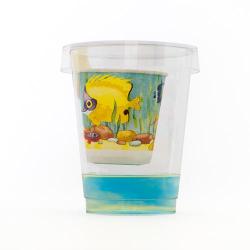Source Institutions
Source Institutions
Add to list Go to activity
Activity link broken? See if it's at the internet archive

Ocean acidification is a problem that humans will have to deal with as we release more and more carbon dioxide into the atmosphere. This activity demonstrates how water can become acidic with the introduction of CO2.
- 5 to 10 minutes
- 5 to 10 minutes
- $1 - $5 per student
- Ages 8 - 18
- Activity, Experiment/Lab Activity
- English
Quick Guide
Materials List (per student)
- Safety goggles
- An acid-base indicator such as bromothymol blue, diluted with water: 8 milliliters bromothymol blue (0.04% aqueous) to 1 liter of water (see the Teaching Tips section below for alternative acid-base indicators, including one made from cabbage juice)
- Two clear 10-oz plastic cups (the tall ones)
- Paper cups, 3-oz size (you’ll only use one in the experiment, but keep a few extras at hand just in case)
- Masking tape
- Plain white paper
- Permanent marker
- Baking soda
- White vinegar
- Two Petri dishes to use as lids for the plastic cups
- Graduated cylinder or measuring spoons
- Gram scale or measuring spoons
Subjects
-
Earth and Space Science
-
Earth Processes
- Weather and Climate
-
Earth Structure
- Oceans and Water
- Atmosphere
-
Earth Processes
-
Physical Sciences
-
Chemistry
- Acids and Bases
-
Chemistry
-
The Nature of Science
-
The Scientific Process
- Conducting Investigations
- Gathering Data
-
The Scientific Process
Other
This resource is part of:
Access Rights:
- Free access
By:
Rights:
- Creative Commons: Non-commercial Share Alike (by-nc-sa), Exploratorium Teacher Institute,
